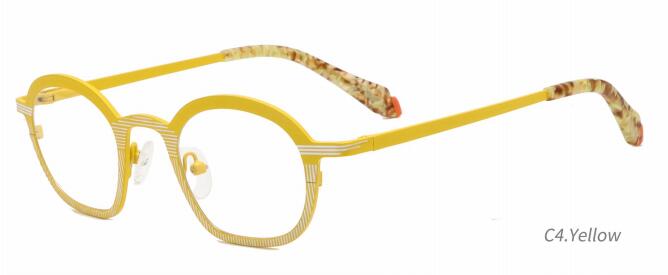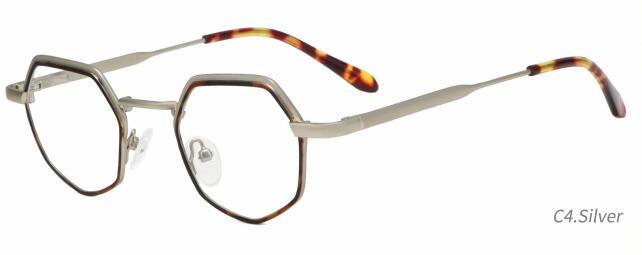Metal Material For Eyeglasses
The metal materials used for frame glasses include copper alloys, nickel alloys, and precious metals. It is required to have a certain degree of hardness, softness, elasticity, wear resistance, corrosion resistance, light weight, luster, and good color. Therefore, the metal materials used to make frame glasses are almost all alloys or used after metal surface processing.
1. White copper frame (copper zinc alloy) (also nickel copper alloy): The main components are copper 64%, zinc 18%, and nickel 18%. The frame material is the cheapest and easy to process. Electroplating is mainly used for manufacturing hinge brackets, small parts, and low-end products.
2. High nickel alloy frame: The nickel content can reach over 80%, mainly including nickel chromium alloy, manganese nickel alloy, etc. High nickel alloy has better corrosion resistance, and in addition, the material has good elasticity.
3. Monel material frame: nickel copper alloy, with a nickel content of about 63% and copper 28%. In addition, there are small amounts of other metals such as iron and manganese, especially corrosion-resistant, high-strength, and firmly welded. It is the most commonly used material for the middle frame.
4. Pure titanium mirror frame: Titanium has a specific gravity of only 4.5, which is very corrosion-resistant and twice the strength of steel. It is used in the manufacturing of space shuttle watch cases and is known as the "space metal", and there is no metal allergy. Early titanium materials had problems such as difficult cutting and welding. With technological development, these problems have been gradually solved in the Japanese market, and titanium has become the mainstream. In the European and American markets, titanium materials mainly come from Japan. Titanium frame is generally represented as Ti-P or TiTAN, and is basically made of titanium except for brackets, hinges, and screws.
5. Memory titanium alloy frame: refers to a new alloy composed of nickel and titanium in an atomic ratio of 1:1. It is 25% lighter than ordinary alloys and has the same corrosion resistance as titanium material. In addition, it has excellent elasticity. Memory titanium alloy: It exhibits shape memory characteristics below 0 ℃, and high elasticity between 0-40 ℃. Memory titanium material is more corrosion-resistant than Monel alloy and high nickel alloy, but it is more resistant than pure titanium and high nickel alloy β- Titanium is slightly inferior.
6 β- TiTAN titanium alloy: refers to a special alloy formed by mixing pure titanium (accounting for 70%) with rare metals such as cobalt and chromium (accounting for 30%). Ultra light and ultra elastic mirror frames can be made very fine. Due to its excellent stability as an alloy of rare metals such as titanium, cobalt, and chromium, it will not cause skin allergies and will have greater development and popularity in the coming decades.
7. Wrapped metal frame: Its process involves adding solder or direct mechanical bonding between the surface metal and the substrate. Compared to electroplating, the surface metal layer of the wrapped material is thicker, and it also has a bright appearance, with good durability and corrosion resistance. The representation of the package number: According to the regulations of the International Conference on Precious Metals, products with a weight ratio of gold to alloy of 1/20 or more are represented by GF, and products with a weight ratio of 1/20 or less are represented by GP.
8. K gold frame: Generally 18 K gold, indicating that the content of pure gold in the frame is 18/24. If represented by 750/1000, it indicates that the content of silver, copper, and other substances is 250/1000. 18K gold glasses, weighing 40g, have a gold content of 18 ÷ 24 × 40=30 grams.
Now you now what is metal material?
Thanks for reading
Sophie Yang
004@mikeeyewear.com


